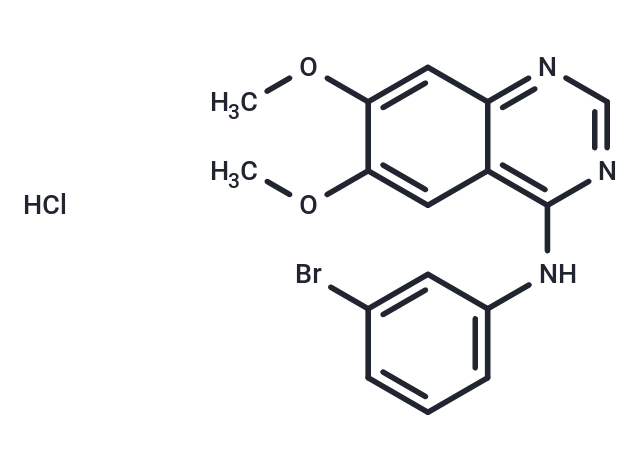Shopping Cart
- Remove All
 Your shopping cart is currently empty
Your shopping cart is currently empty

PD153035 hydrochloride (ZM 252868) is a effective and selective inhibitor of EGFR (Ki: 5.2 pM, IC50: 29 pM); few influence against FGFR, PGDFR, InsR, CSF-1, and Src.

| Pack Size | Price | Availability | Quantity |
|---|---|---|---|
| 5 mg | $30 | In Stock | |
| 10 mg | $37 | In Stock | |
| 25 mg | $75 | In Stock | |
| 50 mg | $147 | In Stock | |
| 100 mg | $250 | In Stock | |
| 500 mg | $568 | In Stock |
| Description | PD153035 hydrochloride (ZM 252868) is a effective and selective inhibitor of EGFR (Ki: 5.2 pM, IC50: 29 pM); few influence against FGFR, PGDFR, InsR, CSF-1, and Src. |
| Targets&IC50 | EGFR:5.2 pM(Ki) |
| In vitro | When administered to HFD-fed mice, PD153035 enhances glucose tolerance, insulin sensitivity, and signaling while reducing subclinical inflammation. In immunodeficient nude mice carrying A431 human epidermoid carcinoma xenografts, PD153035 (80 mg/kg) inhibits the tyrosine kinase activity of the EGF receptor. |
| In vivo | PD153035 exhibits dose-dependent inhibition of nasopharyngeal carcinoma cell lines HONE1 (IC50: 18.6 μM), NPC-TW04 (IC50: 9.8 μM), and NPC-TW01 (IC50: 12.9 μM). It also inhibits the epidermal growth factor receptor (EGFR) tyrosine kinase related to A-431 human squamous epithelial carcinoma (Ki: 5.2 pM, IC50: 29 pM). In Caco-2 colon cancer cells, PD153035 silences COX-2 expression induced by the PAR(2) activating peptide 2-furoyl-LIGRLO-NH(2) (2fLI). Furthermore, PD153035 selectively inhibits EGF-induced tyrosine phosphorylation in Swiss 3T3 fibroblasts and A-431 human squamous epithelial cancer cells (IC50: 15 nM and 14 nM, respectively). When acting on human cancer cell lines overexpressing the EGF receptor, PD153035 suppresses cell growth, including in A431, DU145, Difi, ME180, and MDA-MB-468, with IC50 values of 0.22 μM, 0.4 μM, 0.3 μM, 0.95 μM, and 0.68 μM, respectively. |
| Kinase Assay | Inhibition of EGF receptor tyrosine kinase : Enzyme reactions are performed in a total volume of 0.1 mL containing 25 mM Hepes (pH 7.4), 5 mM MgCl2, 2 mM MnCl2, 50 μM sodium vanadate, 0.5 to 1.0 ng of enzyme (which also contains enough EGF to make the final concentrations 2 μg/mL), 10 μM ATP containing 1 μCi of [32P]ATP, varying concentrations of PD153035, and 200 μM of a substrate peptide based on a portion of phospholipase C-γl having the sequence Lys-His-Lys-Lys-Leu-Ala-Glu-Gly-Ser-Ala-Tyr472-Glu-Glu-Val. The reaction is initiated by the addition of ATP. After 10 minutes at room temperature, the reaction is terminated by addition of 2 mL of 75 mM phosphoric acid, and the solution is passed through a 2.5-cm phosphocellulose filter disk that binds the peptide. The filter is washed five times with 75 mM phosphoric acid and placed in a vial with 5 mL of scintillation fluid. The uninhibited control activity produces approximately 100,000 cpm. |
| Cell Research | Cells are seeded in sixwell plates. The next day, cells are changed to medium containing 0.5% FBS for 18 hours, and then PD153035 is added at various concentrations to the cultures. After 72 hours of treatment, cells are washed once with PBS, harvested with 0.1% human trypsin-l mM EDTA in PBS, and counted with a Coulter counter. The CMK cells grow in suspension and, therefore, do not require trypsinization.(Only for Reference) |
| Alias | ZM 252868 HCl, Tyrphostin AG 1517, SU-5271 Hcl, PD153035 HCl, AG 1517 Hcl |
| Molecular Weight | 396.67 |
| Formula | C16H15BrClN3O2 |
| Cas No. | 183322-45-4 |
| Smiles | Cl.COc1cc2ncnc(Nc3cccc(Br)c3)c2cc1OC |
| Relative Density. | no data available |
| Storage | Powder: -20°C for 3 years | In solvent: -80°C for 1 year | Shipping with blue ice. | ||||||||||||||||||||
| Solubility Information | DMSO: 4 mg/mL (10 mM), Heating is recommended. | ||||||||||||||||||||
Solution Preparation Table | |||||||||||||||||||||
DMSO
| |||||||||||||||||||||

Copyright © 2015-2024 TargetMol Chemicals Inc. All Rights Reserved.